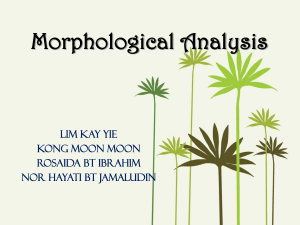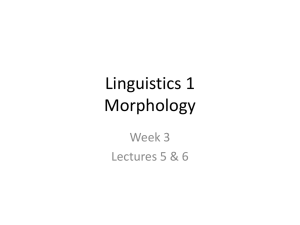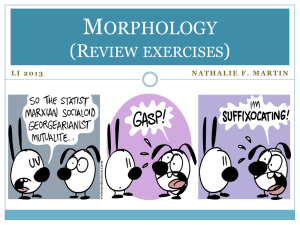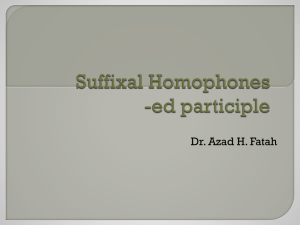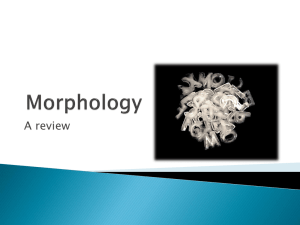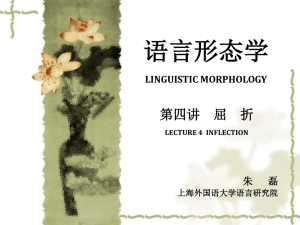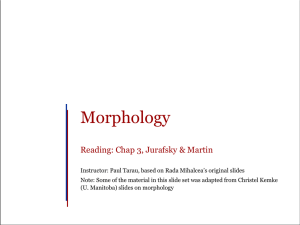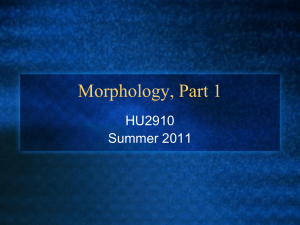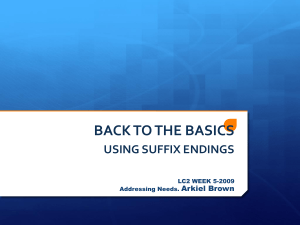Morphology (review exercises for midterm)
advertisement
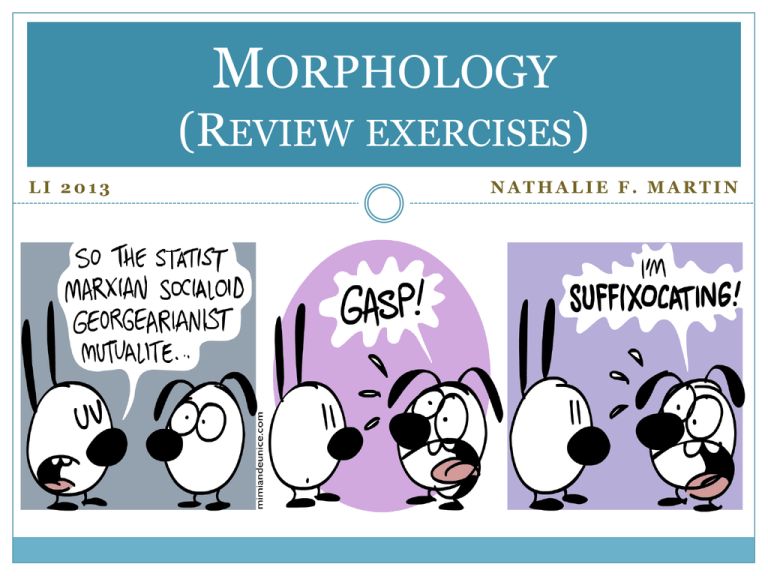
MORPHOLOGY (REVIEW EXERCISES) LI 2013 NATHALIE F. MARTIN What you should know: MORPHOLOGY (chap. 4, Rowe & Levine) Def: Morphology Morphemes: Free, bound morphemes Analysing Word Structure Root, affix Base Affix: prefix, suffix, infixes, circumfix Derivation: English derivational affixes Constraints in derivation Trees MORPHOLOGY (continued) (chap. 4, Rowe & Levine) What you should know: Inflection: Inflection in English Inflection vs. Derivation Compounding: Properties of compounds Other Morphological Phenomenon: Processes: Compounding, Conversion, Clipping, Blending, Back-formation, Acronyms, Onomatopoeia, Eponyms & Trade names, Derivation, Other word formation processes, Foreign word borrowing TABLE OF CONTENT Morphemes Lexical Categories Compound Words Affixation and Trees Bound Morphemes: Inflectional or Derivational? Word Formation Process Overall Review Morphemes WORDS: SIMPLE OR COMPLEX? MORPHEMES: FREE OR BOUND? Simple or Complex Words/Bound Morphems Are these words simple or complex? Circle the bound morphemes. a. Anyways Complex -s b. Forget Forget Simple c. d. e. no bm Undo Complex, unTonight Tonight Complex, no bm Spleeny Spleeny Complex, -y O’Grady, 2009 Free & Bound Morphemes Put a plus (+) sign between morphemes. Label each as bound (b) or free (f) e. Discredit dis (b) + credit (f) Using Use (f) + ing (b) g. Tricycle Tri (b) + cycle h. Delight Delight (f) i. Justify Just (f) + ify (b) f. Free & Bound Morphemes Put a plus (+) sign between morphemes. Label each as bound (b) or free (f) a. Television a. Tele (b) + vision (f) b. Informatory b. In (b) + form (f) + atory (b) c. Farming c. Farm (f) + ing (b) d. Reformation d. Re (b) + form (f) + ation (b) e. Ranch e. Ranch (f) Lexical Categories Exercise: Word class Determine the word class of each of the following words. Is it a content word of a function word? a. b. c. d. e. f. g. h. i. Establishment a to lovely inconvenience adversely submit or from a. b. c. d. e. f. g. h. i. Noun Determiner Preposition Adjective Noun Adverb Verb Conjunction Preposition Compound Words REVIEW Determine the lexical category of these compound word. a. Makeover a. VERB b. Ladybug b. NOUN c. Workbook c. VERB d. Downcast d. ADV e. Firefly e. NOUN f. *Downtrodden f. ADV ADV = N NOUN = N NOUN = N VERB = Adj NOUN = N V = Adj Affixation and Trees Word Structure – Morphological Trees Draw the trees. a) b) Reference: O’Grady & al. (2009) Word Structure – Morphological Trees Draw the tres. c) Reference: O’Grady & al. (2009) Word Structure – Morphological Trees Draw their tree structure. Label the root, the base and the affix Dis satisfi d) Dissatisfied ed Word Structure – Morphological Trees Draw their tree structure. Label the root, the base and the affix d) Activation Bound Morphemes: Inflectional or Derivational? Looking at the AFFIX: Inflectional or Derivational? 1) 2) 3) 4) 5) 6) 7) impermeable plagiarized plagiarize Cats despair fragility slowest 1) Derivational prefix 2) Inflectional suffix 3) Derivational suffix 4) Inflectional suffix 5) Derivational prefix 6) Derivational suffix 7) Inflectional suffix Looking at the AFFIX: Inflectional or Derivational? 8) 9) 10) 11) 12) 13) 14) premade undo whiten beaten oxen slower teacher 8) 9) 10) 11) 12) 13) 14) Derivational prefix Derivational prefix Derivational suffix Inflectional suffix Inflectional suffix Inflectional suffix Derivational suffix Looking at the AFFIX: Inflectional or Derivational? Place a plus (+) sign between each morpheme Label each BM as derivational (D) on inflectional (I). a. Bill’s a. BILL + b. Running b. c. Player c. d. Action d. e. Roughest e. Comes g. Friendly f. f. g. ‘S (I) RUN + ING (I) PLAY + ER (D) * ACT + ION (D) ROUGH + EST (I) COME + S (I) FRIEND + LY (D) Rowe & Levine, 2012 Looking at the AFFIX: Inflectional or Derivational? Place a plus (+) sign between each morpheme Label each as derivational (D) on inflectional (I). h. Unfriendly i. j. k. l. m. n. Longer Loveable Judgment Banana Slowest Quicker h. UN (D) + FRIEND + LY (D) i. j. k. l. m. n. LONG + LOVE + JUDGE + BANANA SLOW + QUICK + ER (I) ABLE (D) MENT (D) EST (I) ER (I) Rowe & Levine, 2012 Looking at the AFFIX: Inflectional or Derivational? Place a plus (+) sign between each morpheme Label each as derivational (D) on inflectional (I). o. Unhappy o. UN (D) + p. Semicircle p. q. Nobody q. r. Aaron’s r. s. Broken (adj) s. s. Broken (v) t. Happily u. t. HAPPY SEMI (D) + CIRCLE NO + BODY AARON + ‘S (I) BROKE + EN (D) * BROKE + EN (I) * HAPPY + LY (D) Rowe & Levine, 2012 Word Formation Process HOW TO NEW WORDS ARE CREATED New Word Formation Process Name all ten word formation processes seen in class: Derivation Compounding Conversion Clipping Blending Back-formation Acronyms Onomatopoeia Eponyms & Trade names Foreign word borrowing SUFFIXOCATING !!! What was the word process used for the word « suffixocating » Homework - Ex 19, p. 144 a) Automation automate a) Backformation b) Humid humidifier b) Derivation c) Information, entertainment c) Blending d) e) f) g) h) i) infotainment Loveseat loveseat d) Progress progress e) Typographical error typo f) Aerobics, marathon aerobathon Act deactivate h) Curve, ball curve ball Compounding Conversion Clipping g) Blending Derivation i) Compounding O’Grady, 2009 Homework - Ex 19, p. 144 j) k) l) m) n) o) p) q) Perambulator pram (the) comb comb (your hair) Beef, buffalo beefalo Random access memory RAM Megabyte meg Teleprinter, exchanger telex Influenza flu GST Goods and Services Tax j) k) l) m) n) o) p) q) Clipping Conversion Blend Acronym Clipping Blend Clipping Initialism O’Grady, 2009 Overall Review Morphology Invent a word using this root : VACUUM 1. 2. 3. 4. by adding a prefix to this base (make sure that there are no constrains to the combination). And then adding a suffix. Draw the structure (tree) of the two words that you have just created. What are the lexical categories of these words? Morphology Invent a word using this root : WORSHIP 1. 2. 3. 4. by adding a prefix to this base (make sure that there are no constrains to the combination). And then adding a suffix. Draw the structure (tree) of the two words that you have just created. What are the lexical categories of these words?

